
4 Real-Life Elevator Pitch Examples to Help Nail Your Own


You’re at a networking event, drink in hand, scanning the room. Then you spot the one person who could change your career.
A top investor. A dream client. A CEO you admire.
You take a deep breath and walk up to them.
You have 30 seconds to make an impression before they move on to the next conversation.
Nail your elevator pitch, and you might land a new opportunity. Fumble, and it’s gone.
But let me cue you in, the stakes are higher than you think.
Research shows that people form first impressions in just seven seconds.
And with attention spans getting shorter, you essentially have very little time to get your message across and make it count.
The good news, however, is that creating the perfect elevator pitch isn’t as hard as you think. Whether you're introducing yourself in a casual conversation or delivering a full elevator presentation to a room of decision-makers, the secret lies in clarity, confidence and knowing exactly what makes your pitch stand out.
In this article, I’ll show you what makes an elevator pitch impossible to ignore, how to write one and break down real-life elevator pitch examples that worked and why. I’ll also round up expert tips to make your pitch unforgettable and share ready-to-use elevator presentation templates to help you deliver it flawlessly.
Psst. Want to watch a video instead? Check out this brilliant YouTube to learn how you can master your elevator pitch:
An elevator pitch is a short, compelling summary of who you are, what you do and why it matters, delivered in 30 seconds or less.
Think of it as your verbal business card. The goal isn’t to close a deal on the spot but to spark interest, start a conversation and open the door to future opportunities.
Originally, elevator pitches were strictly face-to-face exchanges designed for quick interactions. But with digital networking becoming just as important as in-person connections, their role has expanded.
Today, your elevator pitch might show up in a cold email, a LinkedIn bio or even a short-form video. Basically, anywhere you need to grab your audience’s attention.
But what exactly makes a pitch work? It all comes down to structure. Let’s break down the key elements.
A great elevator pitch isn’t just a string of sentences. It follows a structure that keeps people engaged from start to finish. Here’s what every great pitch includes:
Here's an example of what this would look like:
Made with Visme Infographic Maker
An elevator presentation is a visual extension of an elevator pitch that gives you more time, structure and supporting materials to strengthen your message.
Unlike a quick 30-second spoken pitch, it lets you incorporate visuals, data and storytelling elements that make your case more compelling.
Instead of just a brief verbal summary, an elevator presentation can take the form of a one-pager, a slide deck or a short video that visually reinforces your message.
It’s often used in investor meetings, sales pitches and networking events where you have a few extra minutes to leave a memorable impression.
Here’s an example of a one-pager elevator presentation:

This one’s sales-focused and is specially designed for direct-to-consumer (DTC) brands in the wellness and lifestyle space (but can obviously be edited for pretty much any use case).
It has everything you’d need in an elevator presentation: a section for a company overview, product offering, investment breakdown and the real estate to enter your contact number so partners and investors can get in touch.
Design-wise, I love the color combination of this one.
The imagery is not only beautiful but on-theme, and the overall layout is just fantastic. It’s easily scannable, the fonts, data widgets and icons are all terrific and there’s enough whitespace to keep everything looking clean and professional without feeling cluttered.
If you need a visually stunning yet functional elevator presentation, I’d say this is a great starting point.
Let’s look at the qualities that make an elevator pitch truly effective:
At its core, a great elevator pitch should intrigue potential partners and investors and open doors to new opportunities.
You could try to wing it. Go in unprepared, improvise on the spot and hope the right words come out when you need them most.
But let's be real. Unless you’re a natural-born speaker, you’re looking at rambling, awkward pauses and a pitch that just doesn’t land.
Great pitches aren’t made up on the spot. Ideas can spark in the moment, sure. But a successful elevator pitch is crafted with intention, refined with practice and delivered with confidence.
So how do you write one? Let’s break it down.
Made with Visme Infographic Maker
Before you write a single word, ask yourself: What am I trying to accomplish?
Are you:
Once you’ve nailed down your objective, focus your pitch on achieving that one specific goal. A pitch that tries to do too much loses impact.
For example, if your goal is to attract investors, your pitch should highlight your business model and growth potential (not just what your product does). If you’re pitching a client, focus on how your solution benefits them.
When your objective is clear from the start, writing a pitch becomes much easier.
A great elevator pitch isn’t just about what you say. It’s about who you’re saying it to.
An investor, a potential client and a hiring manager all care about different things. If you don’t adjust your pitch accordingly, you risk losing their attention.
Instead, your pitch should speak to your ideal customer profile (ICP) or the specific person you’re addressing. Are they a small business owner, a C-level executive or a tech investor? Each of them has different priorities.
In short, a one-size-fits-all pitch just won’t cut it. Figure out the problem your ICP is trying to solve, the outcome that’ll matter most to them and then frame your pitch in a way that makes it instantly relevant to them.
People’s attention spans are shorter than ever, and if your opening line doesn’t grab them immediately, they’ll tune out before you even get to the good part.
A strong hook makes your audience stop in their tracks, whether it makes them think, laugh or raise their eyebrows in surprise. They should feel compelled to hear you out, so keep it short, relevant and impactful.
A great hook basically sets the tone for the entire conversation. Get it right.
Once you have their attention, don’t waste it. Get straight to the point.
Your audience should immediately understand what you do, who you help and why it matters without needing to ask for clarification. A great way to frame your value proposition is using the [Problem] → [Solution] → [Impact] formula.
The biggest mistake people make is that they overcomplicate their pitch. They use jargon, vague descriptions or try to pack in too much information at once.
Probably the best advice I can give you is to keep it simple, ditch the fluff and make every word count.
At this point, your audience understands what you do. But why should they trust you?
Anyone can claim they have an incredible idea, the best product or the most ground-breaking solution. But without proof, it’s just words.
If you want your elevator pitch to stick, back it up with success stories and sources.
There are a few ways to do this:
Think of this as your mic-drop moment. It reassures your audience that you’re not just making big claims, you have the numbers to back them up.
By now, your audience knows what you do and that you can back it up with proof. But here’s the problem. There are probably dozens (or hundreds) of other companies or professionals offering something similar.
So, why should they care about you?
This is where you differentiate yourself.
What makes your business, product or skill set unique? Maybe it’s your approach toward a problem, the tech you’re using or the business model you’re employing. Whatever it is, position yourself as the better choice in a way that’s clear and specific.
An elevator pitch isn’t a TED Talk. It’s a quick, powerful introduction that should be delivered in 30 seconds or less.
If your pitch drags on, you risk losing your audience’s attention. So keep the elevator pitch short, punchy and engaging.
If you’re unsure whether your pitch is too long, time yourself. If it takes more than a minute, trim the fluff.
Here’s an example:
Instead of saying: “Our company uses state-of-the-art AI-driven predictive analytics to help businesses optimize their marketing workflows”, say: “We help businesses automate marketing using AI.”
Even the best elevator pitch is useless if it doesn’t lead anywhere. If you don’t tell your audience what to do next, the conversation ends before it even begins.
So keep the momentum going by setting up a call, organizing a demo, connecting on LinkedIn etc. Just don’t leave things open-ended.
Yes, a well-crafted elevator pitch is powerful. But a visual elevator pitch is unforgettable.
When you pair your pitch with compelling visuals and data, it becomes easier to understand and far more memorable.
Instead of just telling your audience what you do, show them with a pitch deck, one-pager or even a video.
If you’re looking to design elevator pitch decks to wow potential investors, Visme has dozens of pitch deck templates to choose from.
Pick any design you like (or create a completely new design using Visme’s AI presentation maker), upload your branding, tweak the text and design and either share with your clients online or print a high-quality version for in-person meetings.
Whether you’re pitching in person, over email or via video, a professionally designed visual pitch helps you stand out.
Want a step-by-step tutorial on how to create a pitch deck for investors that gets funded? Check out this video:
The best way to learn how to write a compelling elevator pitch is to see how others are doing it.
Here are four real-life elevator pitches from people who are making an impact, and what makes them work:
Hugh Johnston, a 27-year-old entrepreneur with dyslexia, developed an app called Tyypo to assist individuals in learning from their spelling mistakes.
Seeking to gain visibility for his app, Johnston utilized the “Elevator of Dreams,” an initiative at the Shoreditch Virgin Hotel in East London in partnership with Simon Squibb.
The pitch:
Made with Visme Presentation Maker
Hugh’s pitch works because it hooks the audience with a funny, relatable story, making them emotionally invested right away.
He backs it up with stats, showing the scale of the problem and presents Tyypo as a clear, easy-to-understand solution.
Finally, he ends with a strong call to action, making it easy for people to engage.
It got Richard Branson’s attention, he shared it with his audience which doubled the platform’s waiting list. An absolute win.
Here’s the video of Hugh’s elevator pitch:
Another great pitch from Richard Branson’s and Simon Squibb’s “Elevator of Dreams” initiative came from Low Rise Brewery—a low-carb beer brand targeting health-conscious consumers who don’t want to compromise on flavor.
The Pitch:
Made with Visme Presentation Maker
Low Rise Brewery’s pitch works because it’s simple, direct and backed by a compelling problem.
It opens with a relatable statement about the UK’s obesity crisis, making the audience immediately see the need for a healthier beer option. Then, it presents the solution in a single, clear sentence—a full-strength craft beer with 40% fewer calories.
The triple “please” adds personality and urgency, making the ask feel genuine.
Finally, the pitch ends with a strong CTA, directing people to their Instagram handle.
Here’s the video of Jimmy’s pitch:
Stryve is a cloud-based Applicant Tracking System (ATS) designed to simplify hiring for growing companies. They’ve shared their pitch on their socials to hook potential partners and clients.
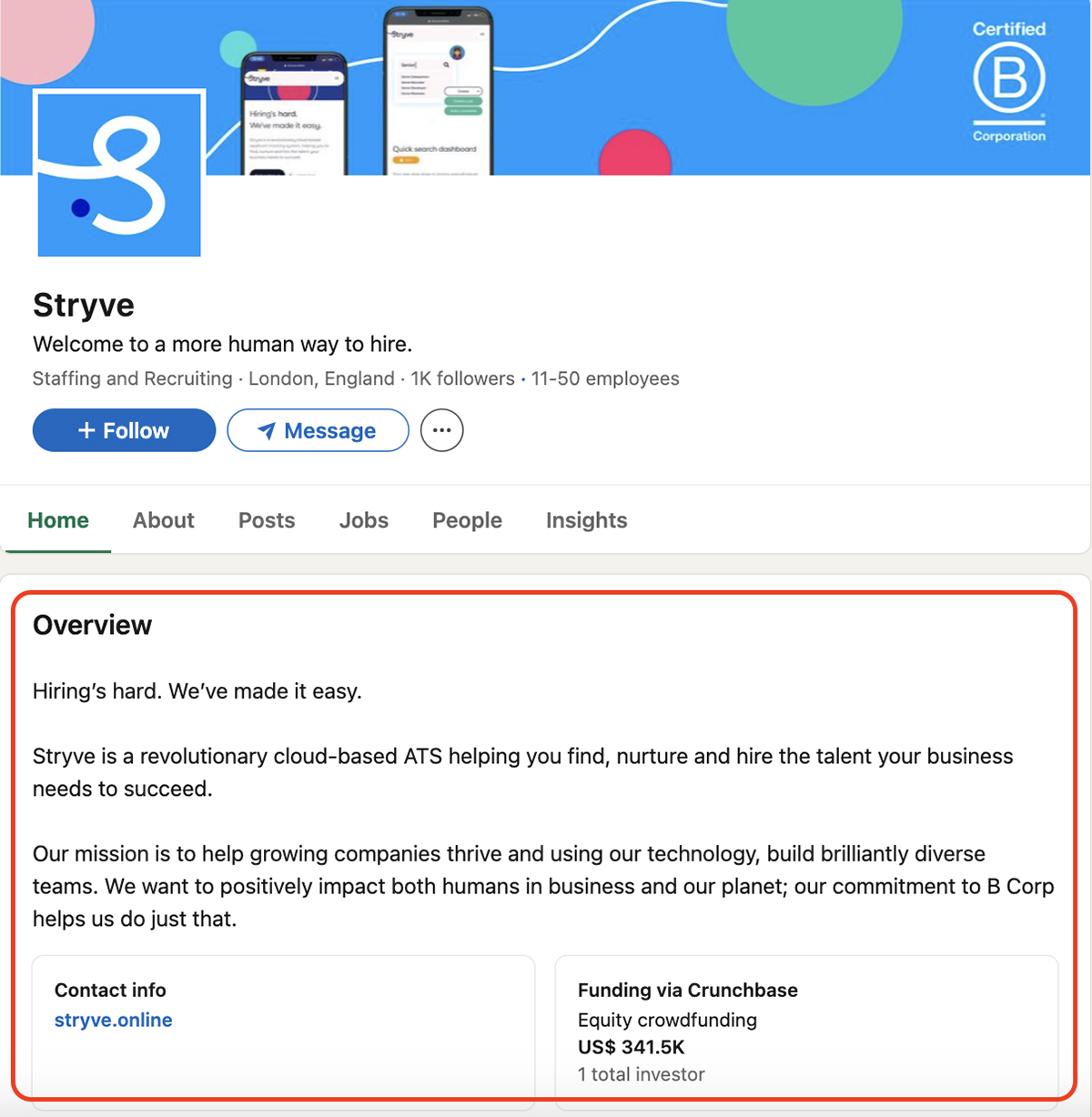
The pitch:
“Hiring’s hard. We’ve made it easy.
Stryve is a revolutionary cloud-based ATS helping you find, nurture and hire the talent your business needs to succeed.
Our mission is to help growing companies thrive and using our technology, build brilliantly diverse teams. We want to positively impact both humans in business and our planet; our commitment to B Corp helps us do just that.”
Stryve’s pitch is short, mission-driven and packs a punch. It immediately acknowledges a common pain point (the challenges of hiring) and follows up with an easy-to-understand solution.
The use of the phrase “Hiring’s hard. We’ve made it easy.” is particularly effective because it’s simple.
Plus, the mention of B Corp certification adds credibility. It shows future partners that Stryve aligns with ethical and sustainable business practices.
Party on Demand is a service that delivers party essentials on-demand, providing everything from drinks and balloons to DJs in an hour or less. Sure, the pitch is 3-minutes long. But you’re going to absolutely love this one.
The pitch:
Made with Visme Presentation Maker
Watch the complete pitch here:
Willie Green’s pitch grabs attention with a relatable problem, delivers a clear value proposition and backs it up with strong market potential.
His high-energy delivery makes the concept memorable, while his simple pricing model ($299 for food, talent and décor) shows affordability. He also validates demand with $150K in revenue in four months and 35 brand partnerships.
Lastly, the “$251B market size” reinforces growth potential, making this pitch data-driven and investor-ready.
I’ve analyzed dozens of elevator pitches while researching this article, so I decided to put my own spin on them. What would I say in these situations?
Here are six 30-second elevator pitches for different scenarios. Feel free to use them for your next pitch or tweak them to match your style.
“Everyone agrees [industry trend] is the future.
But [specific challenge] is the real problem.
We created [solution] at [company name] to [key benefit, e.g. make X easier/faster/cheaper].
We help [target audience] [achieve shared goal] without [common obstacle].
But what makes us different? [differentiator, e.g. a unique feature/process/advantage].
We’re looking for [investment amount] to [funding goal, e.g. scale/expand/launch a new product].
If you want to be part of [big industry opportunity], let’s talk.”
Now, let’s see it in action:
Made with Visme Infographic Maker
This pitch works because it immediately taps into a well-known industry trend and presents a clear, urgent problem that investors can recognize.
Instead of just introducing a solution, it quantifies its impact. The differentiator is simple to understand, and the funding ask is tied to a clear growth plan.
Investors walk away knowing exactly what the product does, why it matters and how their investment will drive real change.
“[Pain point] is a hassle. It takes [time/effort/resources] that most people don’t have.
We built [product/service] at [company name] to [describe key function]. And made it possible for [users] to [achieve key goal] without [common friction point].
You must be wondering if there are other players in the market. Of course, but here’s what sets us apart: [unique selling point].
Here’s my card—it has all my contact details. Feel free to reach out anytime between [available hours]. I’d love to continue this conversation.”
Now, let’s see it in action:
Made with Visme Infographic Maker
The pitch starts with a pain point and quickly introduces a solution. It then accepts the competition in the industry but positions the brand’s USP as the better alternative. Lastly, the close is action-oriented—exactly how it should be.
“Most [target audience] deal with [pain point] every day.
And the worst part? [Consequence of the problem].
At [company name], we created [product/service] to [describe key function], so you don’t have to worry about [pain point] anymore.
Unlike [competitor or traditional solutions], we [unique selling point].
If this sounds like something that could help you, I'd love to set you up with a free [trial/demo/sample] so you can see it in action. If I can grab your [contact info, e.g. email/phone], I’ll share all the details with you.”
Now, let’s see it in action:
Made with Visme Infographic Maker
Again, the pitch starts with a pain point and positions the product/service as a great solution. And instead of a generic call to action, it offers immediate value (a free demo).
“Ever struggled with [pain point]? Yeah, me too.
I’m [your name], a [your role], and I help [specific audience] [achieve goal]—without the frustration of [common obstacle].
Take [past client/success story], for example. They [specific result] just by [solution you provided].
I focus on [key services]. If [pain point] is on your radar, let’s chat! I’d love to help [desired outcome].”
Now, let’s see it in action:
Made with Visme Infographic Maker
This pitch feels like a conversation instead of a scripted monologue. The hook is relatable, the solution is clear and proof of success is baked in naturally without sounding like a brag. And the close is casual yet actionable.
“Hey, I’m [your name], a [your role] specializing in industry or niche].
I help [target audience] [achieve specific goal], so they don’t have to deal with [common frustration].
In the last [timeframe], I’ve worked with [number of clients/companies], and the results have been [positive outcome].
Just recently, I worked with a [specific type of client] who had [challenge]. I [specific action you took], and within [timeframe], their [key result/stat improvement].
If this is something you—or someone in your network—could use help with, I’d love to [offer: show work, set up a call etc.].
I just sent you a [next step: LinkedIn request, email follow-up time]—let’s talk soon!”
Now, let’s see it in action:
Made with Visme Infographic Maker
This pitch is conversational, confident and results-driven. It starts with a clear introduction, moves into real-world impact and ends with an easy way to continue the conversation.
You know how [pain point] can be a total headache?
I hear this all the time from [target audience]—they spend [too much time/money/effort] trying to [achieve a goal], but it’s just not working as well as it should.
That’s exactly why we built [product/service]. It helps [target audience] [achieve key benefit] without [common frustration].
One of our customers [quick success story or result], and they didn’t have to change a thing about how they worked.
But that’s just one example. In the last [X years], we’ve helped [number] of businesses grow, and we’re already doing [revenue milestone or key achievement].
I’d love to show you how it could work for you. How about a quick test drive? I can set you up with a free [demo/trial]—just need your email and I’ll send over the details.
Now, let’s see it in action:
Made with Visme Infographic Maker
This pitch feels dynamic and high-energy, like something you’d hear on Shark Tank. It hooks the listener with a problem, then follows up with a success story, big-picture impact and social proof. The CTA is casual yet direct, making it easy for the prospect to say yes.
You’ve seen real-life examples. You’ve got the structure down. But how do you deliver an elevator pitch that sticks?
I went through advice from top investors, founders and business leaders to gather the best expert-backed tips on crafting and delivering a pitch that grabs attention.
“The customer should never object to you—you should initiate the objection.” — Grant Cardone.
Grant says that if you know common pushbacks (cost, effectiveness, decision-making), address them before the other person does.
For example, instead of waiting for “this sounds expensive,” say: “You might be wondering if this is costly, but our solution actually saves businesses $50K a year.”
This keeps you in control and makes your pitch stronger and more convincing.
“You want to stand out? Build trust. Do the simple things really, really well.” — Vusi Thembekwayo.
According to Vusi, a great elevator pitch isn’t just about what you say. It’s about how much the listener trusts you. If they don’t believe in you, they won’t buy into your idea.
The best way to build trust is to be clear, be consistent and follow through.
“People have the attention span of a gnat. Unless you open with something unexpected and interesting, you’re going to lose them.” — Susan Trumpler.
Susan believes the biggest mistake in an elevator pitch is starting with a boring, generic intro.
Don’t say “Hi, I’m John from X company, and we do Y.” Instead say: “You know that feeling when nothing in your closet fits right? That’s where I come in.”
When you start from the listener’s perspective, you grab their attention and make them lean in, not tune out.
“The typical intro is about you. We try to make it 100% complete and 100% accurate. But the perfect intro is about who you help. It’s interesting. And most importantly, it’s confident.” — Clay Hebert.
Clay believes most people introduce themselves with a job title or a long-winded explanation that no one remembers. Instead, the attention should shift to who we want to help and how we can do it.
An elevator pitch is only as powerful as the way you present it.
Use these one-pager elevator presentation templates to structure your pitch and share it in a clear, compelling format.
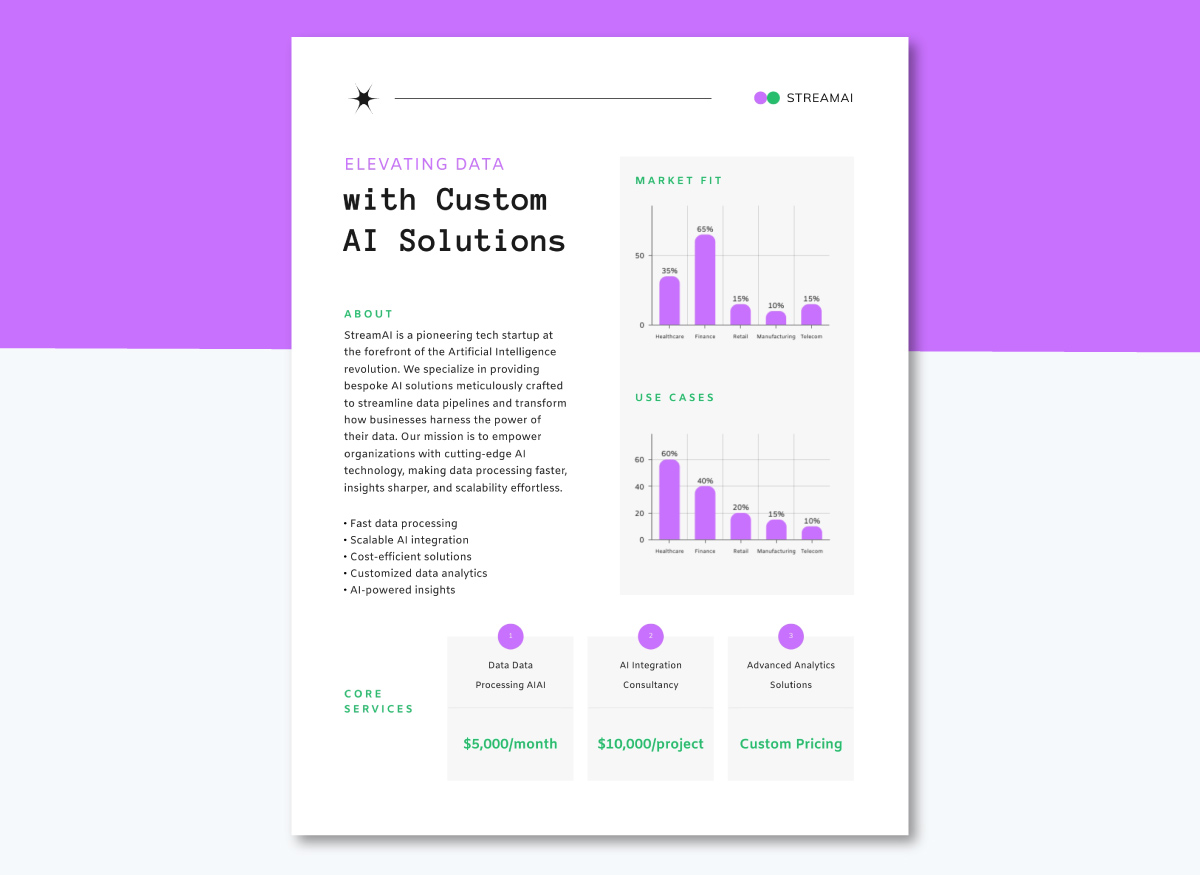
If you’re an AI firm or a small business providing tech-driven solutions, then this one-pager elevator pitch template is exactly what you need.
It features bold headlines, a concise section and a quick pricing and services breakdown at the bottom. I love the clean, color-coded blocks, but what I love even more about this elevator presentation template is the data visualizations that tell a story.
Once you’re done curating your elevator pitch, share and publish it online using the embed code or link. If you want to share it face to face, just download in PDF format and you’re good to go.
In case you’re using the online option, you’ll also be able to track the analytics of your elevator presentation like who saw it, for how long, how many times, from where and so on.
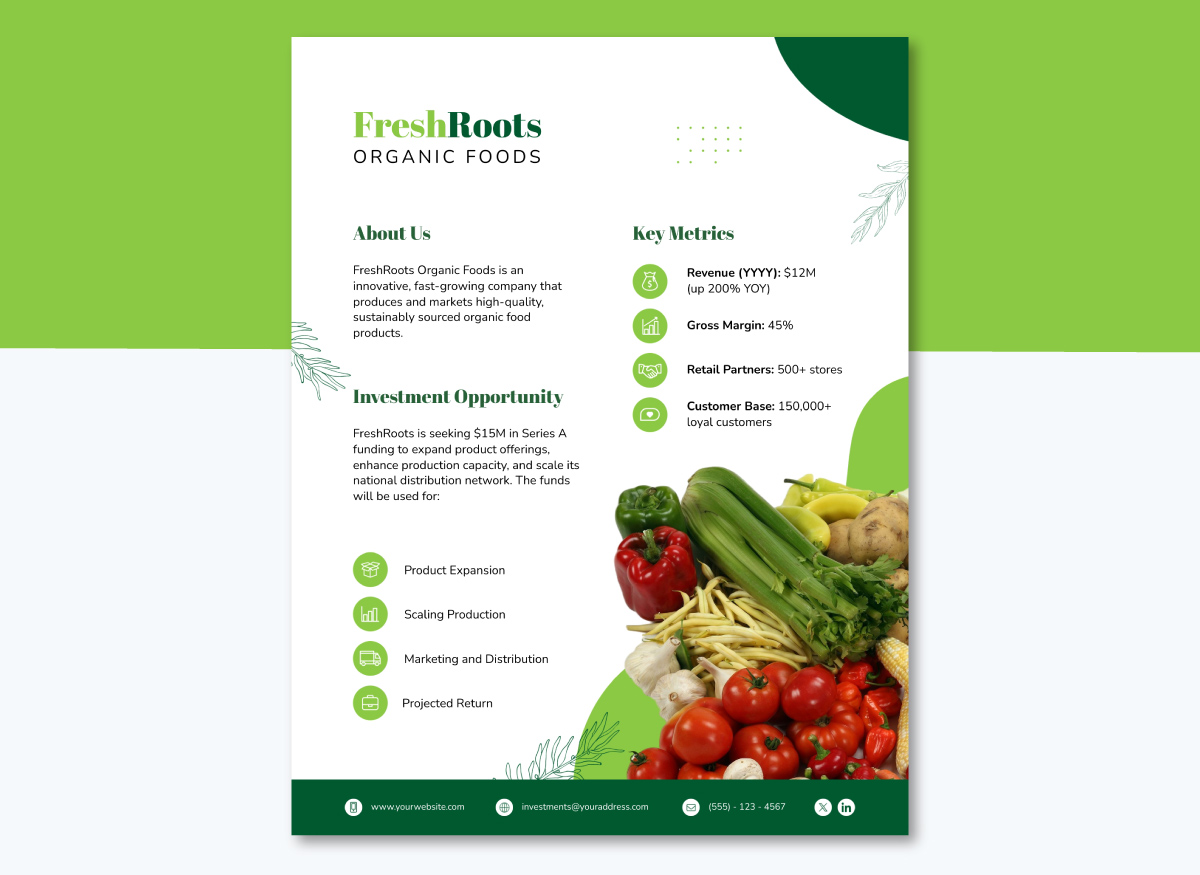
Investors don’t have time to read lengthy proposals. That’s why this food-themed investment pitch one-pager gets straight to the point.
Its vibrant design uses high-res stock images of fresh produce to reinforce the brand’s focus on organic, high-quality food. On the left, the “About Us” and “Investment Opportunity” sections clearly outline the company’s mission and funding goals, while the right side presents key metrics in an easy-to-scan format. Icons, bullet points and structured content ensure the message is clear at a glance.
And, lastly, I love the social media buttons at the bottom. These can also be made clickable and interactive if you’re sending the one-pager to the client online.
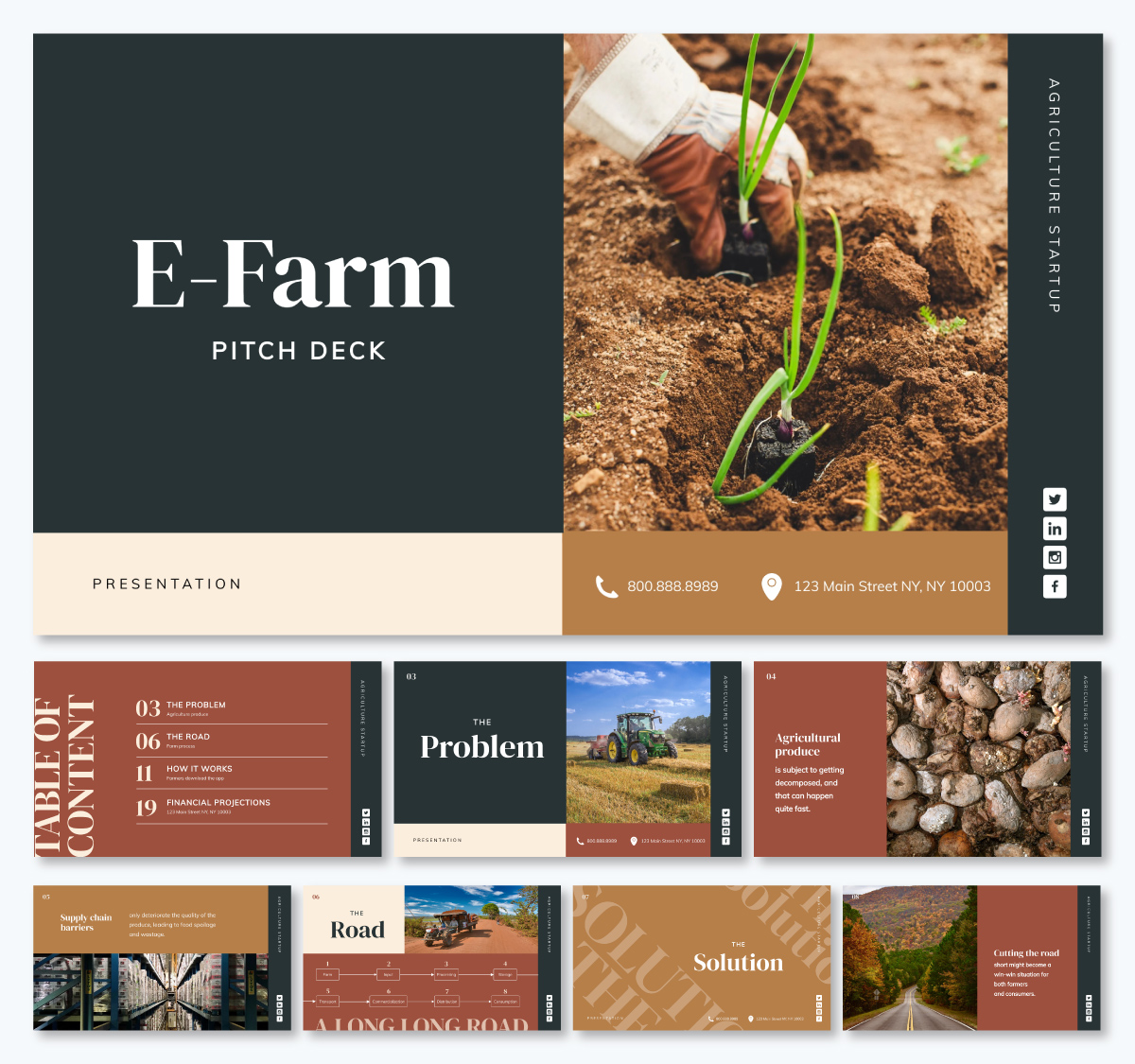
I love the layout, colors and fonts of this multi-page elevator presentation example. But being ‘pretty’ isn't enough. It backs it up with well-thought-out sections, imagery and data widgets that tell a story.
Especially for these text-heavy pitches, it’s sometimes a problem to write everything from scratch. If you face a similar situation, try Visme’s AI writer. Just enter a prompt of what you want written and AI will generate a ready-to-use version.
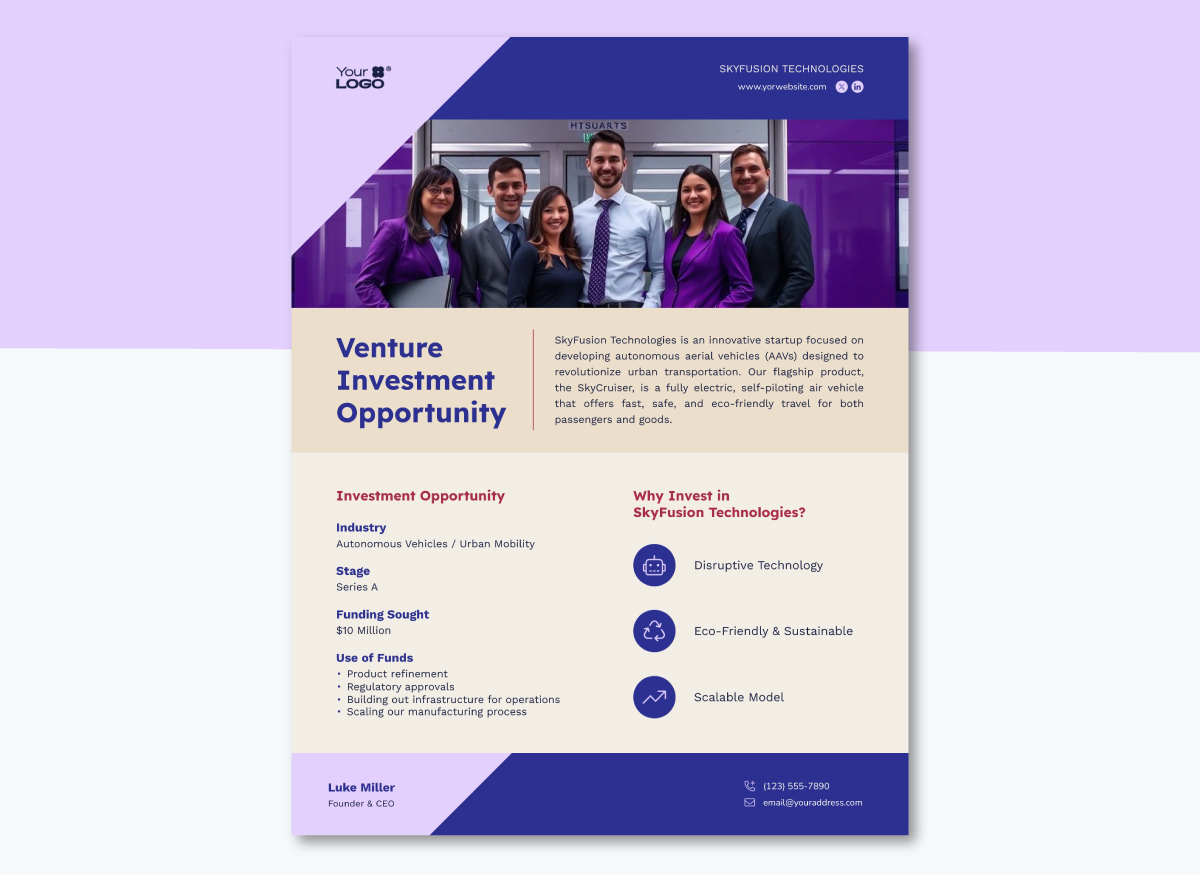
This one-pager elevator presentation template is an ideal pick for startups looking to secure funding in emerging tech, mobility and disruptive industries. Just pick it up, upload your branding kit and content and you’re ready to go.
The template has everything you'd need in an elevator pitch: a company overview, investment details and funding goals and a clear section on why investors should consider your firm.
I also love how well thought out this template is. There’s a dedicated space for your company logo and contact info, including phone number, email and social handles, because making it easy for investors to reach out is just as important as the pitch itself.
An elevator pitch should be no longer than 30 seconds—typically between 75-150 words. Think of it as a quick, impactful summary of what you do.
If your pitch takes too long, you risk losing your listener’s attention. The goal is to spark interest, not explain everything at once.
The three C’s of a strong elevator pitch are:
Instead of just stating your name and job title, focus on the value you provide.
For example, don’t say: “I’m Ethan, a financial consultant.” Say: “I help small business owners save thousands on taxes every year.”
This makes your pitch more engaging and increases the chances of starting a conversation.
A strong elevator pitch gets your foot in the door. But a well-designed visual pitch keeps people engaged.
Throughout this article, we’ve covered what makes a great business pitch, real-life examples that work and expert-backed strategies to refine yours.
Now, it’s time to take it a step further by turning your words into powerful visuals.
With Visme AI, you can design eye-catching elevator pitch presentations, sleek one-pagers and professional investor pitch decks. All designs to help you communicate your message with clarity and impact.
Ready to pitch with confidence? Start creating with Visme's presentation maker and make your next pitch impossible to ignore.
Design visual brand experiences for your business whether you are a seasoned designer or a total novice.
Try Visme for free